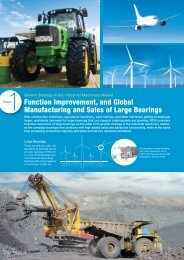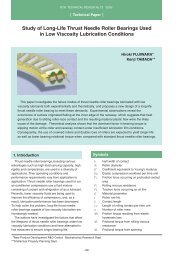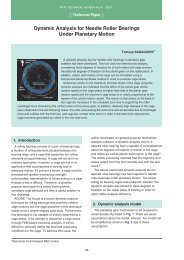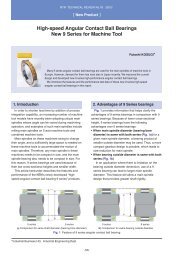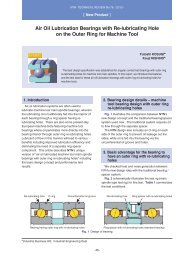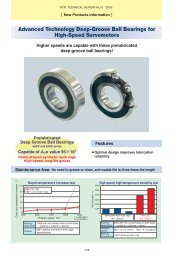Special Issue; Products for Industrial Machinery - NTN
Special Issue; Products for Industrial Machinery - NTN
Special Issue; Products for Industrial Machinery - NTN
You also want an ePaper? Increase the reach of your titles
YUMPU automatically turns print PDFs into web optimized ePapers that Google loves.
Development of a New Grease Lubrication System <strong>for</strong> Machine Tool Main Spindles<br />
of this test is graphically plotted in Fig. 4(b). The<br />
amount of base oil delivery is greater with a greater<br />
temperature difference in each heat cycle. However,<br />
base oil delivery is still possible with a temperature<br />
difference of about 3˚C.<br />
Thus, the minimum temperature difference<br />
necessary <strong>for</strong> base oil delivery through a clearance<br />
seems to be 3˚C. Assuming that a machine tool main<br />
spindle is continuously run <strong>for</strong> an extended period<br />
virtually without stoppage, the authors’ lubrication<br />
system can be applied even though, <strong>for</strong> example, only<br />
periodic temperature variation due to control over the<br />
jacket cooling temperature is available.<br />
3.1.2 Size of radial clearance and associated<br />
amount of base oil delivery<br />
The authors studied the interrelation between the<br />
size of radial clearance at the end point through which<br />
the base oil is delivered and the amount of base oil<br />
delivery. The sizes of the radial clearances adopted<br />
were 0.05 mm, 0.15 mm, 0.2 mm and 0.45 mm. The<br />
differences in temperature in the heat cycles, relative<br />
to the temperatures on the outer rings of the running<br />
bearings (41˚C) were 3˚C (between 41˚C and 38˚C)<br />
and 15˚C (between 41˚C and 26˚C). The heat cycle<br />
patterns shown in Fig. 4(a) are the same as mentioned<br />
previously. After 250 test hours, the measured<br />
amounts of base oil delivery were graphically plotted in<br />
Fig. 5. Grease-B was used in this test and the<br />
properties, are summarized in Table 1.<br />
The absolute value of the amount of base oil<br />
delivery with a temperature difference of 3˚C differs<br />
from that with a temperature difference of 15˚C.<br />
Nevertheless, under each of these different<br />
temperature conditions, a smaller radial bearing<br />
clearance led to a greater amount of base oil delivery.<br />
3.1.3 Effects of different grease types on the<br />
amount of base oil delivery<br />
The authors studied the effect of the type of grease<br />
prefilled in the grease chamber on the amount of base<br />
oil delivery by using the two types of greases<br />
summarized in Table 1. The temperature difference in<br />
each adopted heat cycle was 15˚C, and the size of the<br />
radial clearance used was 0.05 mm. The heat cycle<br />
pattern adopted was the same as that described<br />
Amount of base oil delivery g<br />
1<br />
0.8<br />
0.6<br />
0.4<br />
0.2<br />
Temperature<br />
41˚C<br />
38˚C<br />
41˚C<br />
26˚C<br />
(a)<br />
2h 2h<br />
2h 2h<br />
Time h<br />
Heat cycle pattern<br />
15˚C temperature difference<br />
3˚C temperature difference<br />
0<br />
0 50 100 150 200 250 300 350<br />
Time h<br />
(b)<br />
Base oil delivery versus elapsed time<br />
Fig. 4. Relation between temperature difference and<br />
base oil delivery<br />
Amount of base oil delivery g<br />
Amount of base oil delivery g<br />
1<br />
0.8<br />
0.6<br />
0.4<br />
0.2<br />
0<br />
0.7<br />
0.6<br />
0.5<br />
0.4<br />
0.3<br />
0.2<br />
0.1<br />
15˚C temperature difference<br />
3˚C temperature difference<br />
0.05 0.15 0.2 0.45<br />
Radial clearance mm<br />
Fig. 5 Base oil delivery versus radial gap<br />
0<br />
Grease-A<br />
Grease<br />
Grease-B<br />
Fig. 6 Base oil delivery versus grease property<br />
-11-



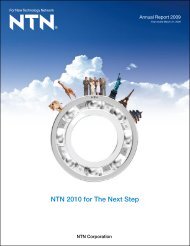
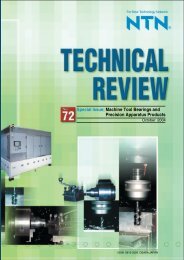
![[New Product] Unit Products for Office Equipment - NTN](https://img.yumpu.com/27154451/1/184x260/new-product-unit-products-for-office-equipment-ntn.jpg?quality=85)
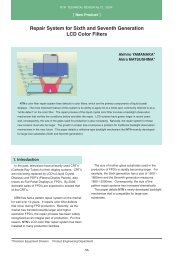
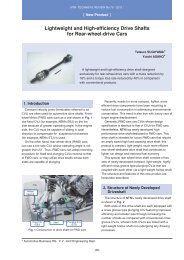
![[New Product] Development of Oil-impregnated Sintered ... - NTN](https://img.yumpu.com/27154427/1/184x260/new-product-development-of-oil-impregnated-sintered-ntn.jpg?quality=85)

